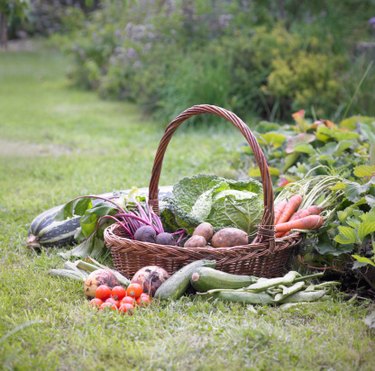
Growing, harvesting and eating homegrown vegetables is a healthy and sustainable practice. A backyard garden allows for a season-long supply of fresh vegetables for your family. A good rule of thumb is to allow 100 square feet of garden space for each member of the family, so a 10-by-20-foot garden plot is ideal for a two-person family.
Low Vegetables
Video of the Day
Plant low-growing vegetables on the southern end of the garden so larger plants will not shade them. Rake out rows based on the spacing requirements detailed on the back of the seed packets, usually six to eight inches wide for these smaller plants. Leave this distance between rows. Sow seeds for lettuce, spinach, carrots, radishes and onions in the rows and thin to the recommended requirements when seedlings are one to two inches tall. Lettuce and radishes can each use up five feet of one 10-foot row. Plant a 10-foot row of carrots, a 10-foot row of spinach and five feet of onions. Change these recommendations based on your vegetable preferences and eating habits.
Video of the Day
Medium Vegetables
Plant medium-height vegetables, such as broccoli, cauliflower, cabbage, peppers and tomatoes in the middle rows of the garden. Rows can range between 12 and 24 inches apart, depending on which vegetables you choose to grow. Plan three to five of each plant per person. Plant four 10-foot rows of potatoes, a common staple that can be kept in cold storage for months. Zucchini, cucumbers and squash varieties may be planted in hills. Since these plants are heavy producers, one plant per person is sufficient.
Vertical Plants
Plant peas and pole beans on the north end of the garden. Use trellises to encourage the vines to climb upright, which will improve vegetable garden quality and save precious space. Plan five rows of each vegetable. Beans can grow in hills, where several plants use a single trellis to conserve space. Keep in mind that cucumbers can be trained for vertical growth, which is helpful if you find yourself growing short on space.
Tall Vegetables
Plant corn and sunflowers on the far north end of the garden. If planting different corn varieties, such as yellow and sweet, keep a few rows of space between them so they do not cross pollinate. Beans grow well with corn, so feel free to plant pole beans intermingled in the corn rows. Plant two 10-foot rows of corn.